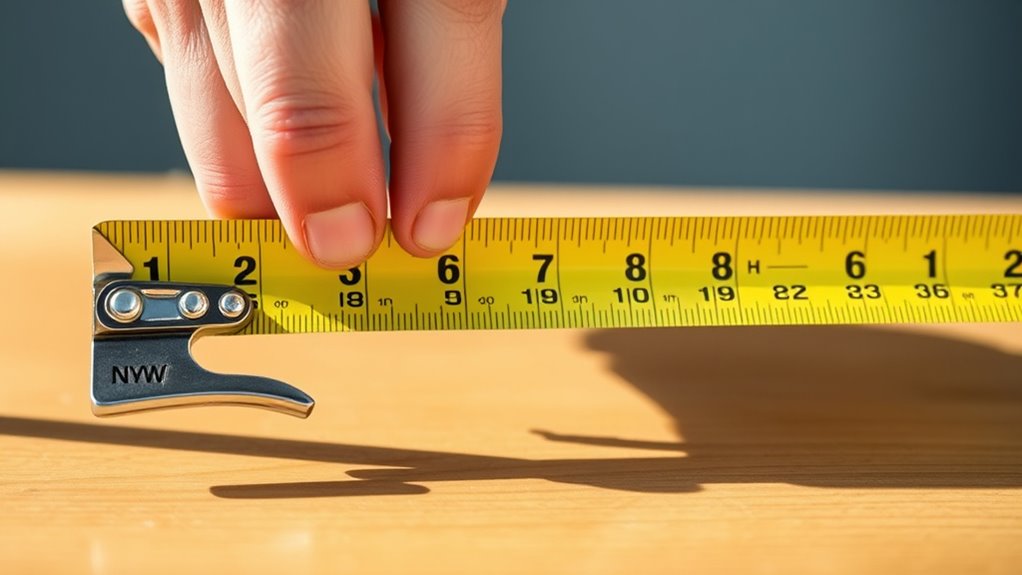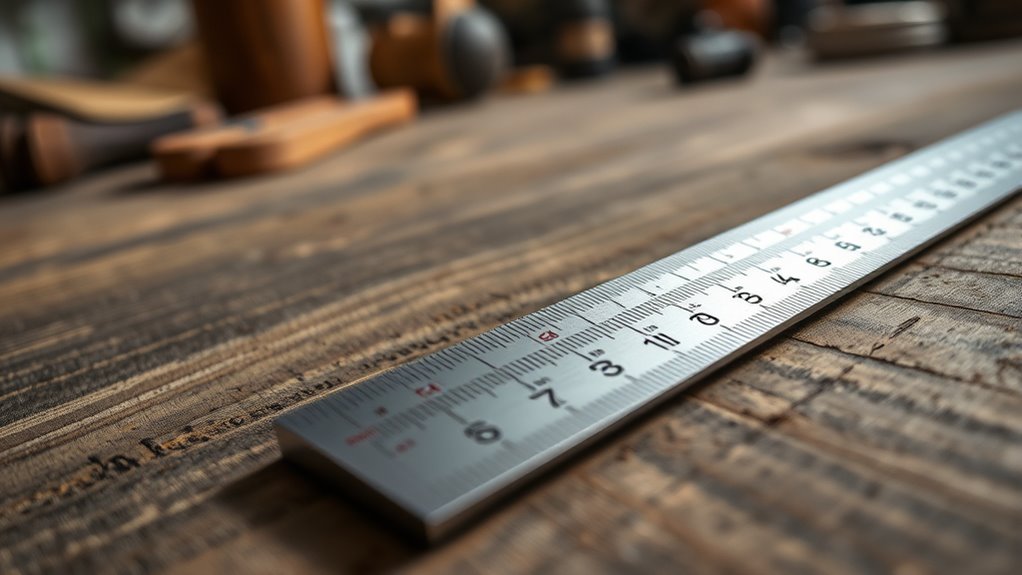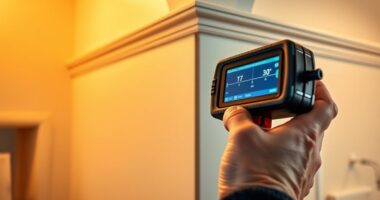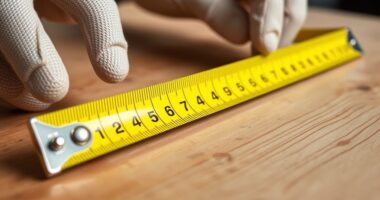To accurately read tape measures, always make certain the zero mark lines up perfectly with the edge of your material before measuring. Keep the tape straight and taut, and look closely at the divisions, recognizing fractional units like halves, quarters, eighths, and sixteenths. Use the hook at the end to grip edges firmly, and double-check measurements in smaller units. If you want to master these skills and avoid costly errors, keep exploring for more tips.
Key Takeaways
- Always align the tape’s zero mark exactly with the edge of your material before measuring.
- Keep the tape straight and taut to prevent slack and ensure accurate readings.
- Recognize and interpret fractional divisions such as 1/8, 1/4, 3/8, and 1/2 inches precisely.
- Verify whether you’re reading metric or imperial units and switch carefully to avoid confusion.
- Double-check measurements by confirming readings from multiple angles for accuracy.

Reading a tape measure accurately is essential for precise measurements in any project. Whether you’re building furniture, hanging pictures, or doing woodworking, knowing how to read a tape correctly can save you time and prevent costly mistakes. One of the most important skills is understanding different marking techniques so you can transfer measurements onto your material with confidence. Proper marking techniques involve not just reading the numbers but also knowing where to mark and how to interpret fractional and metric units. For instance, when you see a measurement like 3/8 inch, you should know exactly where that falls on the tape and mark it precisely. Using the right marking techniques ensures your cuts are accurate and your pieces fit together perfectly. Additionally, many tapes include markings for both metric and imperial units, so understanding how to switch between them is crucial for accuracy.
However, many people fall into common errors that can throw off their measurements. One of these common errors is misreading the tape due to improper alignment. Always ensure the tape’s zero mark lines up exactly with the edge of your material before reading any measurement. If the tape is slack, bent, or not flush against the edge, you might end up reading an incorrect measurement. Another frequent mistake is ignoring the smaller divisions on the tape. Many tapes have inch marks subdivided into halves, quarters, eighths, or sixteenths. Failing to recognize these subdivisions can lead to inaccuracies, especially when working on detailed projects. Always take a moment to identify these smaller marks so you can read the measurement properly.
Another common error is misinterpreting the measurement units. Many tapes feature both imperial and metric units, sometimes on the same side or on opposite sides. Make sure you’re reading the correct scale for your project, and double-check the units if you’re switching between metric and imperial measurements. Also, be cautious when reading measurements near the end of the tape. The tape’s hook or end piece can sometimes shift slightly, leading to inaccurate readings if you don’t account for it properly. To avoid this, always use the tape’s hook to grip the edge of the material and pull it taut before taking your measurement. Recognizing measurement inaccuracies and understanding how to prevent them is key for professional results.
Frequently Asked Questions
How Do I Read a Metric Tape Measure Accurately?
To read a metric tape measure accurately, you need to understand metric conversion and unit differentiation. Look carefully at the numbered markings, which are in centimeters and millimeters. Remember, each centimeter has 10 millimeters, so count the smaller divisions to get precise measurements. Keep your eye level with the tape to avoid parallax errors, and always double-check the markings to confirm correct reading and conversion between units.
What Is the Most Common Mistake When Reading Tape Measures?
A common misreading when using a tape measure happens due to incorrect positioning. If you don’t guarantee the tape’s hook is securely anchored or if you view the measurement from an awkward angle, you risk misjudging the figure. Always double-check your line of sight and make sure the tape is straight and properly aligned. Avoid rushing, and take your time to read the markings carefully to prevent any errors.
How Do I Calibrate My Tape Measure for Precision?
To calibrate your tape measure for precision, start with calibration techniques like comparing it against a certified ruler or standard. Use precision tools to verify its accuracy at multiple points along its length. If discrepancies are found, note the differences and consider replacing or repairing the tape. Regular calibration guarantees your measurements stay accurate, helping you avoid costly mistakes on your projects.
Can Tape Measures Be Damaged Easily, Affecting Accuracy?
Sure, tape measures are as fragile as a soap bubble in a hurricane! Thanks to their limited impact resistance, a sudden drop or snag can easily damage their tape durability, throwing off your measurements. So, handle them with care—avoid drops and rough treatment. Remember, a damaged tape measure isn’t just a sad, bent tape; it risks inaccurate readings, defeating the purpose of your precision work.
Are There Digital or Laser Alternatives to Traditional Tape Measures?
You might wonder if digital alternatives or laser measurement tools can replace traditional tape measures. These modern options offer quick, precise readings without the physical limitations of tape measures. Laser measurement devices are especially helpful for measuring long distances effortlessly. While they can be more expensive, they provide high accuracy and ease of use, making them a great choice for professional or DIY projects where precision is essential.
Conclusion
Now that you know how to read tape measures precisely, you’re equipped to turn chaos into clarity. Imagine the tape as a winding river, with each mark a ripple of accuracy, guiding your measurements with confidence. Just as a skilled navigator charts a course through turbulent waters, you can confidently navigate your projects, ensuring every cut and fit is perfect. Mastering this skill transforms guesswork into precision, making your work not just easier, but truly accurate every time.









